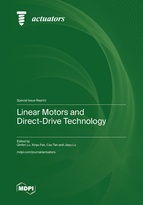Linear Motors and Direct-Drive Technology
A special issue of Actuators (ISSN 2076-0825). This special issue belongs to the section "High Torque/Power Density Actuators".
Deadline for manuscript submissions: closed (30 July 2023) | Viewed by 20900
Special Issue Editors
Interests: analysis, design, and control of linear motors and permanent magnet motor drive systems for automation
Special Issues, Collections and Topics in MDPI journals
Interests: design, optimization, and control of linear motors for energy savings and new energy power equipment
Interests: analysis, design, and control of linear motors and X-by-wire systems for new energy vehicles
Special Issue Information
Dear Colleagues,
In the past decade, linear motors have been widely recognized in various direct-drive fields, such as vehicles, aerospace, industrial production, and others. The topological structure design, optimization, and intelligent control of linear motors is the key to improving the performance of direct-drive systems. The development of permanent magnetic materials, optimization algorithms, and artificial intelligence has brought new vitality to the field. The aim of the present Special Issue is to collect original papers concerned with the theory and application of linear motors and direct-drive technology, without any limitations on the specific application field.
Topics of contributing papers can include, but are not limited to:
- Design and analysis of linear motors;
- Design and analysis of electromagnetic linear actuators;
- Design and analysis of direct-drive systems;
- Modeling and analysis of electromagnetic fields;
- Optimization design strategy;
- Linear motion control;
- Motor fault diagnosis;
- Optimal control schemes.
Prof. Dr. Qinfen Lu
Dr. Xinyu Fan
Dr. Cao Tan
Dr. Jiayu Lu
Guest Editors
Manuscript Submission Information
Manuscripts should be submitted online at www.mdpi.com by registering and logging in to this website. Once you are registered, click here to go to the submission form. Manuscripts can be submitted until the deadline. All submissions that pass pre-check are peer-reviewed. Accepted papers will be published continuously in the journal (as soon as accepted) and will be listed together on the special issue website. Research articles, review articles as well as short communications are invited. For planned papers, a title and short abstract (about 100 words) can be sent to the Editorial Office for announcement on this website.
Submitted manuscripts should not have been published previously, nor be under consideration for publication elsewhere (except conference proceedings papers). All manuscripts are thoroughly refereed through a single-blind peer-review process. A guide for authors and other relevant information for submission of manuscripts is available on the Instructions for Authors page. Actuators is an international peer-reviewed open access monthly journal published by MDPI.
Please visit the Instructions for Authors page before submitting a manuscript. The Article Processing Charge (APC) for publication in this open access journal is 2400 CHF (Swiss Francs). Submitted papers should be well formatted and use good English. Authors may use MDPI's English editing service prior to publication or during author revisions.
Keywords
- linear motors
- electromagnetic linear actuators
- direct drive
- optimization method
- motion control
- fault diagnosis
- mechatronics
- topological optimization
- nonlinear control









